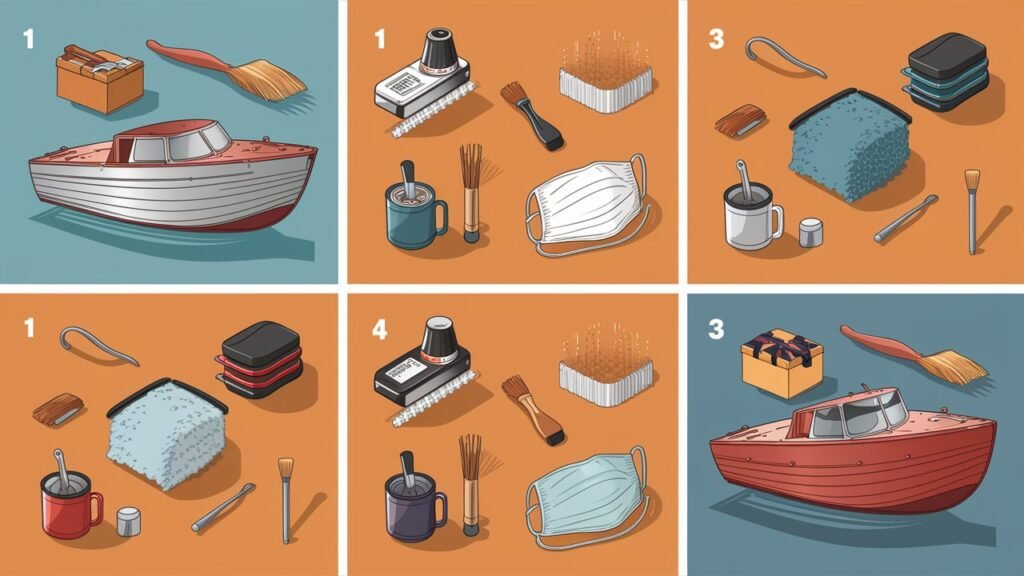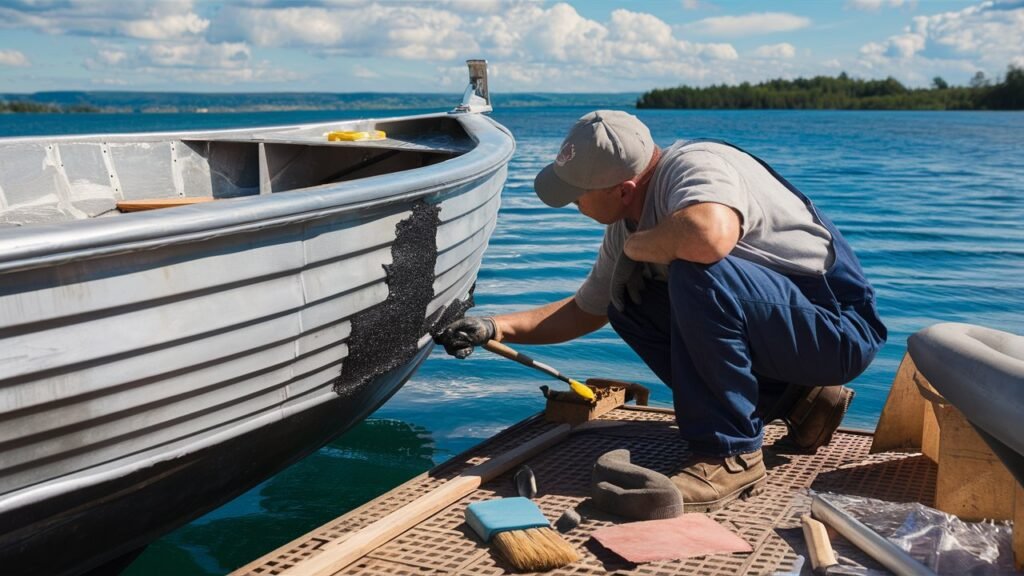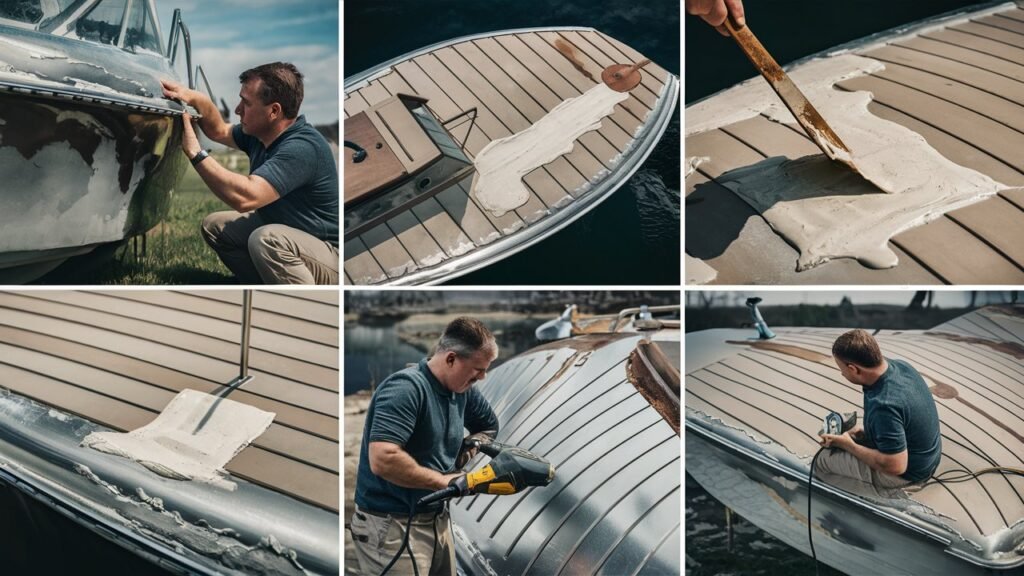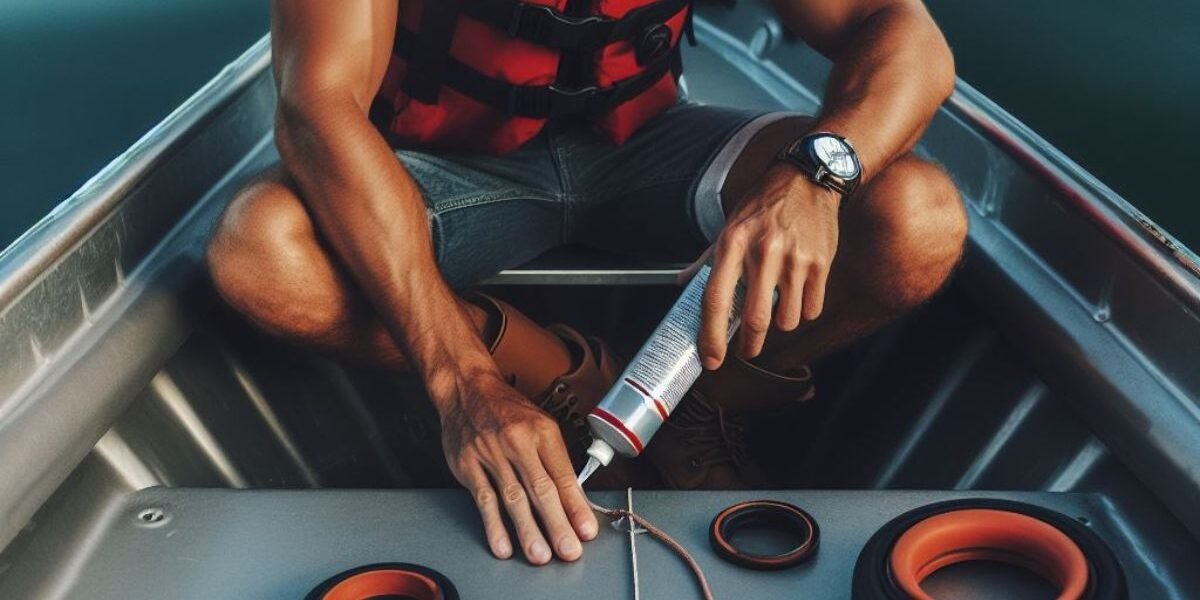How to Seal an Aluminum Boat?
Sealing an aluminum boat may seem like a daunting task, but with the right materials and know-how, it can be a relatively straightforward DIY project.
Gluvit is the best sealant to use if your aluminum boat is leaking.
This flexible sealer works well in marine environments and will permanently fix small leaks in the hull, keel, transom or underfloor.
Before applying Gluvit, it might be necessary to fill any cavities or joints with a marine grade caulk such as 3m 5200.
It is important that you read and understand how 3m 5200 should be applied and cured according to the manufacturer’s instructions.
Being a quick-setting product, it adheres strongly onto aluminium surfaces thereby forming an impervious barrier against water ingress during fishing expeditions, maintenance work or when on transit using trailers.
Another option for a more elastic sealing compound is 3m 4200 which has been designed to withstand flexing and vibrations without losing its effectiveness.
Why is Sealing an Aluminum Boat Important?

For the boat’s structure to be preserved and water kept out of the hull, it must be sealed.
Different issues such as corrosion or rot could be caused by leaks in the boat which, if not properly sealed.
Among other things, 5200 is a good example of superior sealants that can be used for aluminum boats since it ensures they are waterproof.
Depending on whether someone has smooth bottom wetlander or bell tube style vessel choosing the best product to fix it with can greatly influence everything.
To minimize water damage risk, it is advisable that one applies fast cure sealant coupled with correct installation of drain plugs.
When sealing an aluminum boat, ensure you measure carefully and size all parts requiring sealing – this includes at the back where engine mounts are found plus any bolt hole or seam likely to bring about problems.
Tonnes of foam might be needed for sealing gaps or cracks while a plug may require hammering down using a drill for proper installation.
You will need right materials together with required tools so as not only keep your boat afloat but also prevent it from taking on water during those times when you’re out there fishing.
Preventing Leaks in the Hull

Preventing leaks in the hull
In 1995, many boat owners wonder how to get rid of pesky leaks in their hulls. One tip is to carefully inspect the hull for any cracks or damage, and then weld or seal them properly.
An additional method is to make use of a pump for lifting up the boat and moving a slim piece made of plastic or rubber beneath it in order that no water enters.
As per some marine enthusiasts, 5200 adhesive could be used following patches to plug leakages. Nowadays, hp marine sealants have become much commoner among people who have boats for hull maintenance since it is a more recent technology year 2022.
In summary; there is nothing more important than preventing hull leakage when you live on your ship – not only because this ensures safety but also improves living conditions therefore every boater should spare some time for making his or her vessel waterproof.
Protecting the Aluminum Surface
Protecting the Aluminum Surface
Aluminium is a multipurpose metal that is widely used in many areas because it is light and does not rust.
But we need to know how to protect its surface well for long-term use.
A good method of protection involves covering it with a barrier against dampness, chemicals and other elements like coatings that can causeWhat Type of Boating Emergency Causes the Most Fatalities? damage.
Regular cleaning and maintenance of Another important thing is that the aluminum surface should keep clean to prevent dirt from accumulating and causing rusting.
Furthermore, when cleaning it, one should use gentle cleansers and soft clothes so as not to scratch or spoil its smoothness.
As a result of these preventive measures, this material will stay good as new for many more years while serving its purpose without any problems.
What Causes Aluminum Boats to Leak?

boats. These boats may have leakages due to many factors.
One of the most frequent causes is rusting that can make the metal weaker with time and hence create openings or fractures in the ship’s bottom.
Furthermore, collision accidents such as hitting rocks or other hard substances may rupture these vessels by piercing through their aluminum sheets thereby causing water seepage.
Also, bad joining or sealing while building them where two pieces are joined together through welding could enable water entry into this type of boat at points where they were connected if not sealed properly during construction process.
In addition to that another reason why aluminum boats might leak is because people fail to take good care of them leading to deterioration in their condition especially bottoms which makes it easy for holes/leakages to appear on its surface.
It should be noted that irregular checks should be conducted on these vessels so as detect any faults early enough for necessary restoration work to be done which will save both lives and properties boats.
How to Properly Apply Sealant on an Aluminum Boat?
In order to apply sealant on an aluminum boat correctly, the first thing you need to do is check for rivets that may be leaking.
When you identify any, close them with flex seal or epoxy.
Then ensure the boat’s surface is both clean and dry before applying the sealant.
Depending on your choice of sealant, you can use either paint or flex seal.
Cleaning and Preparing the Surface
To get the best outcome, it is important to clean and prepare the surface before starting any project.
You should take a moment to clean the surface whether you are painting a room or applying another coat of varnish.
If dust and grime are present on the surface then the paint or finish may not stick as required hence giving you unwanted results.
Use mild detergent or damp cloth in wiping the surface to remove dirt or grease.
Ensure that you dry the area well before proceeding to next step so that no water damages occur in future.
Incase there are any uneven parts or imperfections on your working area then think about sanding them down until they become smooth which will act as foundation for achieving desired outlooks after completion.
Applying the Sealant to Leaky Area

When dealing with a leaky area, it is important to apply a sealant as soon as possible to prevent further damage.
First, carefully inspect the area to identify the source of the leak.
Once the leak is located, clean and d
When you have a leaky spot, one must apply a sealant immediately to avoid further damage.
Firstly, inspect the region cautiously to find where it is leaking.
After finding the leakage, clean and dry the surface entirely so that the sealant can stick well.
Then prepare a sealant basing on what the manufacturer says and apply it abundantly on affected parts of an object.
Next use putty knife or any other flat-edged instrument similar to it that spreads an even layer while also getting rid of any bumps or unevenness caused by patchwork smoothing things out with wider strokes until you get near edges or corners not reached by such tools before now scraping away excess material finally leaving behind smoothly leveled finish ready for painting without need sanding off rough spots beforehand if desired simply coating over them too much trouble anyway let’s move onto another step after this one shall we okay thank.
ry the surface thoroughly to ensure the sealant will adhere properly.
Next, prepare the sealant according to the manufacturer’s instructions and apply it generously to the affected area.
Then, use a putty knife or similar tool to spread the sealant evenly and smooth out any lumps or bumps.
Finally, allow the sealant to dry completely before testing the area for any remaining leaks.
By following these steps, you can effectively seal off the leak and prevent any future water damage.
Tools and Materials Needed for Sealing an Aluminum Boat
A few necessary tools and materials are needed for sealing an aluminum boat.
First of all, you should have a marine sealant of good quality. For instance, a polyurethane sealant designed specifically for use on aluminium.
This sealant is important because it will keep your boat watertight as well as protect it from the weather.
Another thing needed in addition to this is a cleaning solvent which gets rid of any dirt or grease or old sealant left behind on the boat before applying new ones.
To apply the sealants neatly and evenly, use a caulking gun.
Lastly, putty knife or spreader can be used to smooth out the sealant and ensure that there is tightness with which these two surfaces meet each other while being sealed against one another so they do not allow any liquid through them when pressed together firmly enough during application or otherwise handled roughly after drying had occurred but before cure time has elapsed completely;
this would make them stay stuck forever thereafter without ever coming apart again until destroyed intentionally somehow thereby resulting in destruction of both parts at once instead of just separating them apart easily later if need be – thus achieving their intended purpose adequately enough than expected even despite all these difficulties encountered during its realization sometimes but not always…
With such tools and materials at hand one can effectively seal his/her aluminum boat ensuring its top condition for many years ahead.
Proper Sealants and Coatings
Different surface areas need protection from different things like moisture, heat or chemicals and this is where appropriate sealants and coatings come in.
What they basically do is filling gaps or holes that may allow water or air into a structure. On the other hand, Coatings are applied on top of surfaces so as to prevent corrosion caused by various factors such as UV rays from the sun.
After all materials have been chosen it is important to apply them correctly because if not it won’t stick properly which means that they will not last long enough thus wasting both time and money for repair works.
Regular checking should be done also with an aim of increasing their life span thereby reducing frequent servicing which could end up being costly in terms of finance needed for such activities.
Even though many people think about using sealants only when building houses, they can still be used during construction works carried out at industrial or commercial sites too.
When one invests in good quality sealants, there are high chances that they might serve him for quite some time saving Thus making savings becomes easy since not much has been spent on buying replacements every now and then.
conclusion
For this reason, it is important to seal an aluminum boat so as to maintain its soundness and ensure that those on board are safe.
When faced with leaks that may cause water damage to their boats, individuals can use first-rate sealants like Gluvit or marine grade caulks such as 3m 5200 or 3m 4200. Failure to protect the hull, keel, transom and seams – which are susceptible areas – can lead to corrosion and rot.
Moreover, safeguarding the aluminium surface through coatings and regular upkeep is vital in extending the life of the vessel as well as optimizing its speed capabilities.
By following the recommended steps and using the right tools and materials, boat owners can confidently seal their aluminum boats and enjoy many years of safe and worry-free boating adventures.




